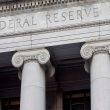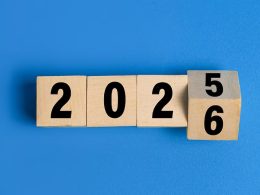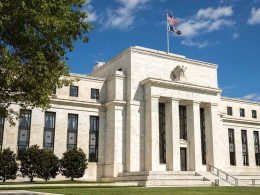by Jurrien Timmer, Director of Global Macro, Fidelity Management & Research Company
The Breakers or bust.
This week I was privileged to be part of our Canadian sister organization’s due diligence conference in Palm Beach. The Breakers Resort did not disappoint, of course, and neither did the quality of my fellow Fidelity speakers, the wonderful event organizers, and the hundreds of Canadian investment advisors who attended.
I learned a lot, as I always do, and it was fitting to stay at an iconic venue built during America’s Gilded Age. I say fitting because in 2025 there is a potential gold rush underway for the next gilded age being created in the AI space. And ironically, that original gold rush from the 19th century has been getting a strong revisit this year with gold hitting $4837 last week. It’s pretty amazing that two such disparate investments have posted such similar returns in 2025. I've been looking at the SPAC index, which you'll see in the charts below. The SPACs are special purpose acquisition companies and are on the move again largely due to the AI fever.

Gold and AI might seem like an odd couple at first, but perhaps it’s not that odd. Gold has been rallying in part as a play on US fiscal dominance (which would include below-market interest rates and therefore the need for a store of value), and in part as a play on what could be a new multipolar world order in which the US dollar loses some of its hegemony.
In recent days, however, the animal sprits have cooled a bit as renewed talk of US-China tariffs resurfaced and some tremors appeared among speculative lenders and smaller banks. This resulted in a selloff in some of the more speculative corners of the market, including bitcoin, SPACs, recently issued IPOs, and nonprofitable tech.

I did quite a few media interviews in the last week, and all of them included a conversation about whether we are in an AI bubble. To me, the market continues to look OK. We are in year 4 of a cyclical bull market, and while earnings are doing the heavy lifting, the parallels to the late 1990’s continue to pop up. Let’s explore the weight of the evidence below.
The trend is our friend
The S&P 500 is now considerably above its rising trendline, while market breadth is at best adequate. It’s not the best backdrop in the world, but for an aging bull market it’s not that surprising either.

Outside the US, markets are looking better, with competitive fundamentals, better breadth, and lower multiples. A barbell of cap-weighted S&P 500 and MSCI EAFE still seems like a solid strategy to me.

Earnings season
With earnings doing the heavy lifting in 2025, valuations are taking a breather following two years of return amplification. This is what we generally want to see in the later stages of a cyclical bull market.

Q3 earnings season is underway, and despite some tremors from some banks, the 58 companies who have reported so far are beating estimates by an average of 571 bps. So far, the expected growth rate has bounced modestly from 7% to 8%.

Bonds are concerned about growth
Meanwhile, bond yields fell below 4% as concerns mount about the economy’s health. As the chart shows below, since 2022 all moves below 4% reversed as quickly as a beach ball held under water. I expect the same could happen this time around.

Rangebound dollar
The US dollar index continues to sit in a range, punctuated by the recent lows (96-ish) and the bottom of the previous range (100). My sense is that the next phase will be lower, but perhaps the crowded short sentiment needs to get less crowded first.

1990’s analog
The analog to the late 1990’s continues to play out, with the post-tariff tantrum rally looking almost identical to the post-LTCM rally in late 1998. We’ll see if the parallel continues.

Netscape = ChatGPT?
If the post-1994 soft landing bull market was launched by the Netscape IPO in August 1995, the current post-2022 soft landing rally seems punctuated by the launch of ChatGPT in late 2022. If we take that analog literally (indexed to those dates and shown on the same log scale), we get the chart below. It suggests that the AI boom is still in its infancy, the 75x P/E on the SPAC index notwithstanding (and that’s just for the profitable ones).

1998 = 2025?
However, if we adjust the analog by using the April 2025 and October 1998 correction lows and loosening our grip on the y-axis, we get the next chart, which suggests that we are further along the analog.

My guess is that we are closer to the former than the latter, especially considering all the bubble talk happening right now. Bubbles usually don’t burst while everyone is bracing for one. They burst when the sceptics who saw one coming (and sold too early) succumb to their FOMO and come back in at the top.
Secular context
If the current cyclical bull market ends up “blowing off” with an AI-driven melt-up, then it’s worth pondering what this would mean for the secular bull market. By my count (with which most technicians disagree), the current secular regime began in 2009 and is now 16 years old. That’s pretty close to the past two secular bull markets (1982-2000 and 1949-1968), with the caveat that this is hardly an exact science with a tiny sample size.

The 5th (and last) cycle
The chart below shows the secular waves and market cycles expressed as sine curves. We can see that we are in the 5th cyclical bull market within this secular wave. That’s exactly the pattern for the 1982-2000 wave and pretty close to the 1949-1968 wave. It’s something to keep in mind as we enter year 4 of this 5th market cycle since 2009.

The 5th (and last) cycle
The chart below shows the secular waves and market cycles expressed as sine curves. We can see that we are in the 5th cyclical bull market within this secular wave. That’s exactly the pattern for the 1982-2000 wave and pretty close to the 1949-1968 wave. It’s something to keep in mind as we enter year 4 of this 5th market cycle since 2009.

When does the gold rush end?
With gold soaring from $1,617 in 2022 to $4,380 last week, it’s worth asking if us gold bulls should ring the bell and take the gains? It’s tempting, considering how much gold has outrun the global money supply recently.

Baton pass?
By comparison, bitcoin’s trajectory looks a lot more modest, having moved in tandem with global M2. Perhaps a baton pass is due between the physical and the digital?

Bookends
The periodic table below (which shows rolling 3-month returns) highlights the recent disparity between gold and bitcoin. They are now bookends on the leaderboard.

Sortino rankings
However, if we show 5-year Sortino ratios instead of returns, we see that both gold and bitcoin (as well as other alternative assets) have dominated the risk-adjusted return landscape for some time now.

Fully valued?
One reason to contemplate ringing the golden bell is that if gold is a play on US fiscal dominance, one could argue that the run is now complete. The chart below shows US M2 against the above-ground value of gold plus the market value of bitcoin. During times of monetary inflation, the market value tends to soar to at least the value of M2, if not more. At $29 trillion, gold and bitcoin are now 133% of M2, which is very close to the peak in 1980. It’s something to keep in mind after gold’s stratospheric run.

A play on two trends
However, when assessing our exposure to gold and bitcoin, it’s worth remembering that this is a play on two trends: US fiscal dominance, which could include negative real rates and therefore the use case for gold, and a move towards a multipolar world in which the dollar standard gets increasingly challenged (hence causing gold reserves to increase).
Below we see the trajectory for US growth and US yields. The rule of thumb is that for debt to be sustainable the rate of economic growth needs to be higher than the cost of the debt. Based on the CBO’s projected growth rate and the Fed forward curve, it looks like the debt will become unstainable in a few years, barring either a growth spurt (AI?) or financial repression. The stakes are high.

Dollar hegemony
If financial repression becomes a byproduct of fiscal dominance, the dollar risks losing some of its supremacy. The USD and Swiss Franc have been the undisputed leaders for many years.

Of course, most other countries are equally guilty of running large debts, and this has left the US as the cleanest dirty shirt. But perhaps this shirt will get some stains as well, leaving only gold (and perhaps the Swiss Franc) as the squeaky clean currencies.

I mention this because perhaps its unfair to compare gold and bitcoin to just the US money supply. If this is a global gold rush, then perhaps we should compare these hard currencies to the global money supply. At $115 trillion (and having nearly tripled in 20 years), the share of gold and bitcoin stands at a mere 26%.

This information is provided for educational purposes only and is not a recommendation or an offer or solicitation to buy or sell any security or for any investment advisory service. The views expressed are as of the date indicated, based on the information available at that time, and may change based on market or other conditions. Opinions discussed are those of the individual contributor, are subject to change, and do not necessarily represent the views of Fidelity. Fidelity does not assume any duty to update any of the information.
Copyright © Fidelity Management & Research Company















